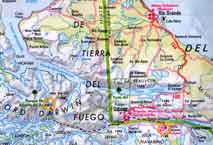
Date: Monday, March 7th 2005
Time: 10:00 pm
Location: S 54.78676 W 69.56073
Temperature: 0°C 32°F
Wind speed: 20 mph 17 knots
Wind chill: -25°C 20°F
Altitude: 300m
Weather: Snowy and Grey
It rained all night long and turned to heavy slush at 09:00 this morning. By 12:00 the slush had turned to heavy snow and was accumulating fast. Erich and I took turns collecting fresh precipitation samples every few hours and everyone else spent the majority of the day either holed-up in their tents or pottering around camp in rain gear boiling water for tea. Visibility was down to less than 50m, far too risky to attempt the descent back to base camp, better to sit the storm out and wait for a brighter spell.
The snow and hail was relentless all day. At one point we thought it was clearing up, we spotted a patch of blue sky and then it was snowing again. The newly forming moulin surfaces froze overnight and are now building up a layer of snow on top. This makes them hard to see and quite hazardous to travel.
Moulins are typically formed as meltwater on the glacier surface plunges down a preexisting hole, crack, or crevasse. Holes form as melt water collects into pools on the surface of the glacier. The pools melt deeper and deeper into the glacier, becoming quite wide in the process. We threw a large boulder into one to see how deep it was and the boulder fell so far that we lost sight of it. Eventually, the pools melt deep enough into the glacier that they join up with subsurface melt water channels, draining in the process and leaving large, deep holes.
Previous journal entry, Next entry, return to Patagonia home

 This project is supported by a grant from NOAA, Office of Global Programs
This project is supported by a grant from NOAA, Office of Global Programs 


